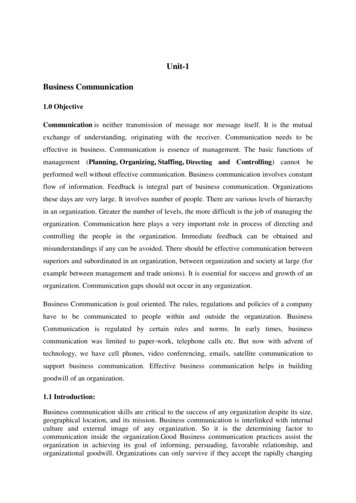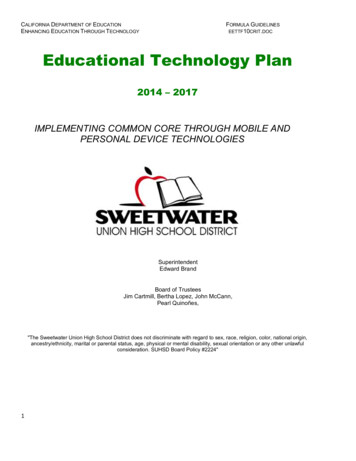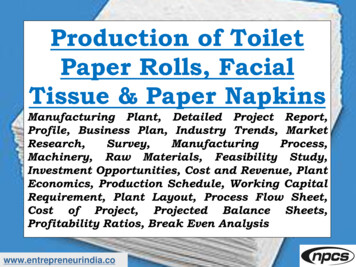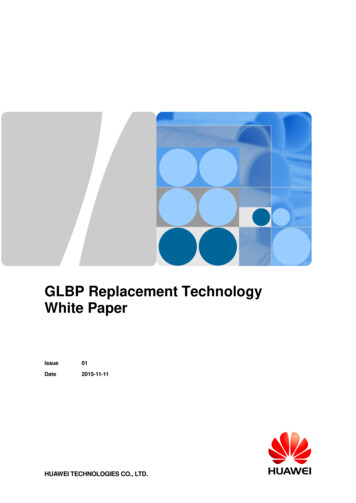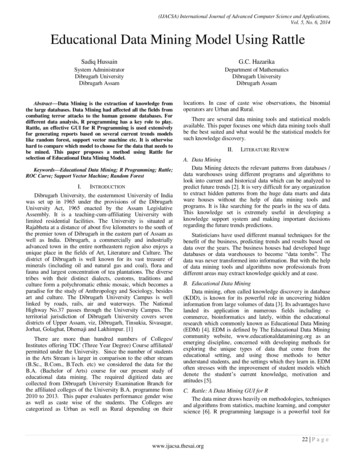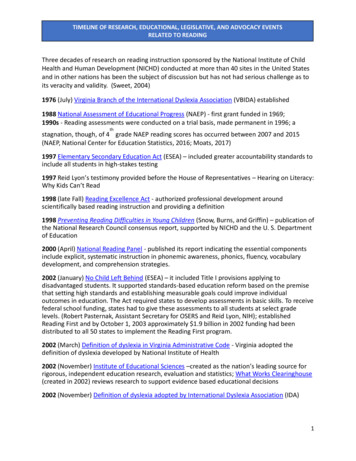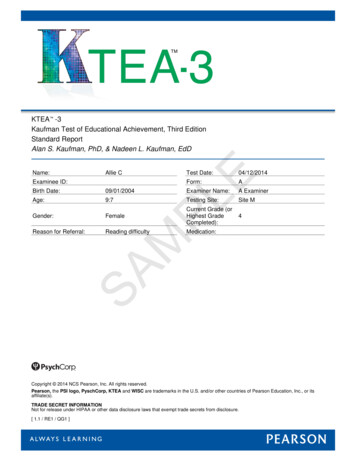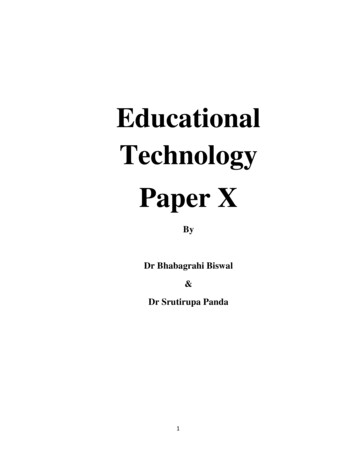
Transcription
EducationalTechnologyPaper XByDr Bhabagrahi Biswal&Dr Srutirupa Panda1
Unit 1Concept of EducationalTechnology2
Unit 1Concept of Educational TechnologyStructure1.0Introduction1.1 Objectives1.2 Meaning of Educational Technology1.3 Scope of Educational Technology1.4 Significance of Educational Technology1.5 Components of ET1.5.1 Hardware1.5.2 Software1.6 Educational Technology and Instructional Technology1.7 Let us Sum up1.8 References1.0IntroductionThis is the era of technology where we are utilizing scientific techniques for solving problemsand improving the life. However for acquiring education also we are implementing technology tomake teaching learnig easier, simple, and comprehensive. This technology is known aseducational technology which is saving time and energy and assisting learner progressively.As it is the first unit of course we are making this chapter comprehensive to make youunderstand the meaning, scope m, significance and components of educational technology1.1 Objectives3
After going through this unit , you will be able to Define educational technology Explain the scopes and significance of educational technology Differentiate Hardware and software Identify gardware and software in educational technology. Distinguish Educational Technology and Instructional technology.1.2 Meaning of Educational TechnologyEducation as a broad discipline that is responsible for changing behavior of individual withthe help of suitable method, strategies and techniques of teaching and learning. From thetime of traditional Guru Sisya parampra till date drastic changes have been observed in thisregard. In this modern era of 21st century of science and technology the complex process ofteaching learning has been modified and simplified by the use of educational technologywhich is nothing but application of modern technology in the field of educational process.You can understand the meaning of educational technology by dividing it into two words―education‖ and ―technology‖: Education is the process of acquiring and imparting cognitive,affective, psychomotor development on the part of the learner with a suitable strategy.Education is a discipline which is both science and art. It is a mixture of science of learningand arty of teaching. However technology refers to the systematic application of scientificprinciples in terms of tools, machines and other expertise to achieve an objective which as aresult of use can design and create new devices that enriches human productivity as well asolves the problems. Hence technology is applied for human development and worked as aproblem solving inventions.Educational TechnologyTechnology refers to the techniques as also the technical contrivances. A systematic way ofapplying the techniques to achieve an objective is as important as the use of technical equipmentfor the same. As a matter of fact, techniques are reckoned as the software and the equipment asthe hardware of technology. Technology results in new designs and devices as also new ideasand processes. Each new physical device is accompanied by a new set of procedures andtechniques. For example, the development of telephone has led to phone books, answering4
machines, fax, telephone shopping, etc. the ‗hard‘ component (physical device) for the purposeof study.Educate the act or process of acquiring and imparting knowledge is crucial to the development ofa learner with a view to his/her participation in the transformation of the world for a bettertomorrow. Learning and understanding are basic to the definition of education.Educational technology is not a simple combination of these two words as shown in fig. its isusually thought of even more than the sum of the following two interpretation;1. Technology in education2. Technology of educationEarly developments referred to the role of technology in education which signifies the use ofaudiovisual equipment, i.e., hardware in educational processes. Later developments recognizethe concept of technology of education, i.e., techniques and methodologies of the teachinglearning process. This is indeed the software aspect of educational technology. The origin ofsoftware is closely associated with the courseware, i.e., instructional design and development ofa subject.Thus Educational technology is a science of techniques and methods by which educationalgoals can be realized. . It is helpful for preserving, transmitting and advancing the knowledgeutilizing suitable tools and techniques such as computer, television, CD etc. Henceeducational technology utilizes several machines such as television, radio, tape recorder,video tapes with principles engineering and principles of physical sciences and behavioralscience for improving the teaching and learning process of education.Educational technology deals with(i) analysis of instructional tasks/challenges and setting the educational objectives(ii) selection and construction of suitable machine, tools, instrument(iii) selection and use of appropriate techniques to run the machine/devices to achieve theeducational objective5
(iv)Integration of scientific and technological skills/ techniques with appropriate behavioraloutcomeThere have been several definitions of educational technology developed over time. Let usgo through them to get the better understanding on the term ―educational Technology‖.Educational technologyis the development, application and evaluationof systems, techniquesand aids to Improve human learning .(National Council for Educational Technology for theUnited Kingdom (NCET, 1967).It is the application of modern skills and techniques to the requirement of education andtraining. (Derik Unwin , 1969).Educational technologyis an applicationof scientific knowledgeabout learning and conditionsof learning to improve the effectiveness and efficiency of teaching and learning. (Leith,1975)Robert A. Cox"Educational Technology is the application of scientific process to man's learning conditions."John P. Dececco"Educational Technology is the form of detailed application of psychology of learning topractical teaching problems"E.E. Hadden"Educational Technology is that branch of educational theory and practice concerned primarilywith the design and use of messages which control the learning process."Richmond, "Educational Technology is concerned to provide appropriately designed learningsituations which, holding in view of objectives of the Teaching of Training, being to bear thebest means of instruction."S.S. Kulkarni, "Educational Technology may be defined as the application of the laws as well asrecent discoveries of science and technology to the process of education."6
S.K. Mitra, "Educational Technology can be conceived as a science of techniques and methodsby which educational goals could be realized."Robert A. Cox Article The Process of Educational Technology: A Tool for Development 1970)."The application of scientific process to man's learning conditions is what has come recently tobe called 'educational or instructional' technology."D.E.S. Working Party (U.K.), "Educational Technology is the development, application andevaluation of systems, techniques and aids in the field of human learning."Robert M. Gange defined Educational Technology as "The Development of asset of systematictechniques and accompanying practical knowledge for designing, testing and operating schoolsas educational systems."Educational technology is the effective use of technological tools in learning. As a concept,it concerns an array of tools, such as media, machines and networking hardware, as well asconsidering underlying theoretical perspectives for their effective application.(Richey 2008)Educational technology includes numerous types of media that deliver text, audio, images,animation, and streaming video, and includes technology applications and processes such asaudio or video tape, satellite TV, CD-ROM, and computer-based learning, as well as localintranet/extranet and web-based learning. Information and communication systems, whetherfree-standing or based on either local networks or the Internet in networked learning,underlie many e-learning processes. Tavangarian , Leypold , Nölting , Röser ,(2004)Richey defined educational technology as "the study and ethical practice of facilitatinglearning and improving performance by creating, using and managing appropriatetechnological processes and resources".(Richey 2008). The Association for EducationalCommunications and Technology (AECT) denoted instructional technology as "the theoryand practice of design, development, utilization, management, and evaluation of processesand resources for learning.[( Randy Garrison and Terry Anderson2003). According toUNESCO, ― Educational technology is a communication process resulting from theapplication of the scientific methods to the behavioral science of teaching and learning. This7
communication may or may not require the use of media such as television broadcasts, radio,cassetts etc‖1.3 Scope of Educational TechnologyEducational technology refers to the use of both physical hardware and educational theoretics. Itencompasses several domains, including learning theory, computer-based training, onlinelearning, and, where mobile technologies are used, m-learning. Accordingly, there are severaldiscrete aspects to describing the intellectual and technical development of educationaltechnology: educational technology as the theory and practice of educational approaches to learning educational technology as technological tools and media that assist in the communicationof knowledge, and its development and exchange educational technology for learning management systems (LMS), such as tools forstudent and curriculum management, and education management information systems(EMIS) educational technology itself as an educational subject; such courses may be called"Computer Studies" or "Information and Communication Technology (ICT)"Hence educational technology helps to develop the teaching, learning, testing and trainingactivities in terms of achieving educational goals1.4 Significance of Educational Technology Access to variety of learning resources : In the era of technology. ET aids plenty ofresources to enhance the teaching skills and learning ability. With the help of ET now itis easy to provide audio visual education. The learning resources are being widens andwiden. Now with this vivid and vast technique as part of the ET curriculum, learners areencouraged to regard computers as tools to be used in all aspects of their studies. Inparticular, they need to make use of the new multimedia technologies to communicateideas, describe projects, and order information in their work.8
Immediacy to information : ET has provided immediacy to education. Now in the year ofcomputers and web networks the pace of imparting knowledge is very fast and one can beeducated anywhere at any time. New IT has often been introduced into well-establishedpatterns of working and living without radically altering them. For example, thetraditional office, with secretaries working at keyboards and notes being written on paperand manually exchanged, has remained remarkably stable, even if personal computershave replaced typewriters. Any time learning : Now in the year of computers and web networks the pace ofimparting knowledge is very fast and one can be educated .One can study whenever hewills irrespective of whether it is day or night and irrespective of being in India or in USbecause of the boom in ET. Collaborative learning : Now ET has made it easy to study as well as teach in groups orin clusters. With online we can be unite together to do the desired task. Efficient postalsystems, the telephone (fixed and mobile), and various recording and playback systemsbased on computer technology all have a part to play in educational broadcasting in thenew millennium. The Internet and its Web sites are now familiar to many children indeveloped countries and among educational elites elsewhere, but it remains of littlesignificance to very many more, who lack the most basic means for subsistence. Multimedia approach to education : Audio-Visual Education, planning, preparation, anduse of devices and materials that involve sight, sound, or both, for educational purposes.Among the devices used are still and motion pictures, filmstrips, television,transparencies, audiotapes, records, teaching machines, computers, and videodiscs. Thegrowth of audio-visual education has reflected developments in both technology andlearning theory. Studies in the psychology of learning suggest that the use of audiovisuals in education has several advantages. All learning is based on perception, theprocess by which the senses gain information from the environment. The higherprocesses of memory and concept formation cannot occur without prior perception.People can attend to only a limited amount of information at a time; their selection andperception of information is influenced by past experiences. Researchers have found that,9
other conditions being equal, more information is taken in if it is received simultaneouslyin two modalities (vision and hearing, for example) rather than in a single modality.Furthermore, learning is enhanced when material is organized and that organization isevident to the student. These findings suggest the value of audio-visuals in theeducational process. They can facilitate perception of the most important features, can becarefully organized, and can require the student to use more than one modality. Authentic and up to date information : The information and data which are available onthe net is purely correct and up to date. Internet, a collection of computer networks thatoperate to common standards and enable the computers and the programs they run tocommunicate directly provides true and correct information. Online library : Internets support thousands of different kinds of operational andexperimental services one of which is online library. We can get plenty of data on thisonline library. As part of the IT curriculum, learners are encouraged to regard computersas tools to be used in all aspects of their studies. In particular, they need to make use ofthe new multimedia technologies to communicate ideas, describe projects, and orderinformation in their work. This requires them to select the medium best suited toconveying their message, to structure information in a hierarchical manner, and to linktogether information to produce a multidimensional document. Distance learning : Distance Learning, method of learning at a distance rather than in aclassroom. Late 20th-century communications technologies, in their most recent phasesmultimedia and interactive, open up new possibilities, both individual and institutional,for an unprecedented expansion of home-based learning, much of it part-time. The termdistance learning was coined within the context of a continuing communicationsrevolution, largely replacing a hitherto confusing mixed nomenclature—home study,independent study, external study, and, most common, though restricted in pedagogicmeans, correspondence study. The convergence of increased demand for access toeducational facilities and innovative communications technology has been increasinglyexploited in face of criticisms that distance learning is an inadequate substitute forlearning alongside others in formal institutions. A powerful incentive has been reduced10
costs per student. At the same time, students studying at home themselves save on traveltime and other costs. Whatever the reasoning, distance learning widens access forstudents unable for whatever reason (course availability, geographical remoteness, familycircumstances, individual disability) to study alongside others. At the same time, itappeals to students who prefer learning at home. In addition, it appeals to organizers ofprofessional and business education, providing an incentive to rethink the most effectiveway of communicating vital information. Better accesses to children with disabilities : Information technology has brought drasticchanges in the life of disabled children. ET provides various software and technique toeducate these poor peoples. Unless provided early with special training, peopleprofoundly deaf from birth are incapable of learning to speak. Deafness from birth causessevere sensory deprivation, which can seriously affect a person's intellectual capacity orability to learn. A child who sustains a hearing loss early in life may lack the languagestimulation experienced by children who can hear. The critical period for neurologicalplasticity is up to age seven. Failure of acoustic sensory input during this period results infailure of formation of synaptic connections and, possibly, an irremediable situation forthe child. A delay in learning language may cause a deaf child's academic progress to beslower than that of hearing children. The academic lag tends to be cumulative, so that adeaf adolescent may be four or more academic years behind his or her hearing peers.Deaf children who receive early language stimulation through sign language, however,generally achieve academically alongside their hearing peers.The integration of information technology in teaching is a central matter in ensuring quality inthe educational system. There are two equally important reasons for integrating informationtechnology in teaching. Pupils must become familiar with the use of information technology,since all jobs in the society of the future will be dependent on it, and information technologymust be used in teaching in order to improve its quality and make it more effective.Specific Significance access to variety of learning resources immediacy to information11
anytime learning anywhere learning collaborative learning multimedia approach to education authentic and up to date information access to online libraries teaching of different subjects made interesting educational data storage distance education access to the source of information multiple communication channels-e-mail,chat,forum,blogs,etc. access to open courseware better accesses to children with disabilities reduces time on many routine tasks1.5 Components of ETThe educational technology composed of mainly two components such as hardware andsoftware. Both hardware and software is equally important for effective application ofeducational technology. For example an interactive computer programme is worthlesswithout suitable educational programme. Both hardware and software are complementary toeach other.1.5.1HardwareHardware denotes technology in education that involoves electronic devices based on scientificprinciples and techniques.Its origin is in Physical Sciences & Applied Engineering and it is basedon the concept of Service. It adopts a Product-oriented Approach.It is concerned with theproduction and utilization of audio-visual aid material[ such as charts, models, slides, filmstrips,audio cassettes, etc.], sophisticated instruments and gadgets[ such as radio, television, films,projectors, tape-recorders, video player, teaching machines , computers, etc.] and mass media.Hardware Technology utilizes the products of Software Technology [such as teaching strategies,teaching learning material, etc.] for its functioning. Hardware technology has the potential to12
hand over the educational benefits to the mass with greater ease and economy Too much use oftechnical gadgets may mechanize the process of teaching-learning as the Hardware approachtries to enter education from outside, operating more in isolation than in combination.1.5.2 SoftwareSoftware denotes technology of education which involves a systematic, scientific application ofappropriate scientific research both from physical science, social science such as psychology andsociology, philosophy, management studies etc. to solve educational problems. It is sometimesreferred to as Teaching Technology, Instructional Technology or Behavior Technology. Itsorigin is in Behavioral Sciences and the applied aspects of Psychology of learning. It is aProcess-oriented Approach. It utilizes the knowledge of the Psychology of Learning to producelearning material, teaching – learning strategies, etc.[Software Technology] for the betterment ofthe process of teaching-learning It does not provide direct services to its users. Instead, it helpsin the production of various Software materials which are used for developing the hardwareappliances.It includes teaching strategies, learning material, evaluation tools, teaching models,programmed instruction, etc.Software technology does not require any aid form the hardwaretechnology for its delivery. It becomes more useful and productive when assisted by theHardware Technology. Software technology does not have mass appeal and is costlier in thelong run, as compared to hardware technology.1.6 Educational Technology and Instructional TechnologyThe terms educational technology and instructional technology may seem interchangeable,but they in fact have important subtle differences, when understood can make the differences13
to an educator(s) planning and implementation of instruction. The analysis betweeneducational technology and instruction technology are in fact found at the roots ofTheir definitions.Education is defined as the "activities and resources that support learning" (AECT, 2004,p.1). This refers to all activities and resources both planned and unplanned that contribute toa students' learning regardless of whether the learning is intentional or unintentional. On theother hand , instruction refers to " activites structured by someone other than the learner andoriented toward specific ends"(AECT, 2004,p.1). Instruction is part of the education as awhole but instruction, unlike education, is carefully mapped out in every detail.Educational technolgy is defined as "the study and ethical practice of facilitating learningand improving performance by creating using, and managing, appropriate technologicalprocesses and resources" (AECT. 2004. p.3). The application of theory, technology, andpsychology to achieve the goal of education and enhance the learning of individuals isnothing bur educational technology.Educational technology Is responsible for Development of teaching and learning Applies theories of instruction, learning, behavioral and cognitive psychology toassessment, design, implementation, and evaluation of instructional material. Applies research, theory, technologies, and psychology to solve instructional andperformance problems. The particular approach used to achieve the ends of education.Educational technologist Design instruction Produce instructional materials Manage instructional computing services or learning resources collections. Apply theories of cognition and research to utilize technology for the benefit of thelearner.14
Instructional Technology is defined as "the theory and practice of design, development,utilization, management, and evaluation of processes and resources for learning" (Seelsand Richey, 1994, p.1).Hence instructional technology referes to the use oftechnological processes as a tool specifically for teaching and learning which facilitatesaccess to information of all types. It is a broad term and Deals with the process of usingtechnology for instruction. It Describes the technologies that facilitate access toinformation of all types. Its functions are Acquisition, processing, storage, anddissemination of information in all of its forms and Evaluation, management, andintegration of instruction with tools available. However instructional technologist (i)Identify and analyze problems of instructional design.(ii) Devise and implement solutionsto those problems.(iii) Integrate people, procedures, ideas, and devices for the purpose ofproviding tools which enhance the learning process.It would seem that Instructional and Educational Technology are synonymous. Thesimple definition for each makes the distinction of their difference: Instructional Technology isthe tool. Educational technology is the procedure for using that tool.Contrast the characteristics of educational technology and Instructional technologyEducationalInstructionalTeaches about technology as a content areaTeaches with technology (uses technology as a tool)Key words: integration and educationKey words: learning environments, instructional systemsand processShape curriculum or solve performanceFocus more on the development and creating of the learningsystem that involve some type of technologyPrimary Goal: Technological literacy for everyonePrimary Goal: To enhance the teaching and learning processConcerned with the broad spectrum of technology (HowPrimarilyhumans have designed and innovated the natural world )information and communication technologiesconcernedwiththenarrowspectrum1.7 Let us Sum upIn this unit you have learnt about the concept of educational technology with its scopes andsignificance. You have also got an idea about hardware and software components ofeducational technology.To make educational universalize in our country it is really needed15of
that educational technology should grow properly with its quality. This unit has alsodistinguished educational technology from instructional technology.1.8ReferencesAssociation for Educational Communications and Technology. (2004). The meaning 20of%20ET 4.0pdtonfromwww.indiana.edu/-May14,2015.Dugger, W; & Nalik, N. (2001). Clarifying misconceptions between technology //iteaconnect.org/TAA/Resources/TAA Differences.html on May 14, 2015 . This articleprovides clarification about the purpose and direction of technology education andeducationaltechnology aswellasstandards ised inboth educationalareas.Seels, B; & Richey, R. (1994). Retreived from 015.This site defines the field of instructional technology and also describes each urces/TAA Differences.htmlonRetreivedMay14,from2015.This power Point slide helps explain the differences betwen technology education andeducational technology.16
Unit 2Communication andInstruction17
Unit 2Communication and InstructionStructure2.0Introduction2.1 Objectives2.2Concept of Communication\2.3. Theory of Communication2.4Nature of Communication2.5Process of Communication2.6 Components of Communication2.7 Types of Communication2.8 Classroom communication2.9. Mass media approach in E.T2.10 Designing Instructional system18
2.11. Formulation of Instructional Objectives2.12Task Analysis2.13 Designing of Instructional strategies-lecture,teamteaching,discussion,seminar and tutorials2.14 Let us Sum up2.15References2.0 IntroductionIn the previous unit you got an idea about educational technology and its significance as well asits components. You found that educational technology can help the teacher and taught tocommunicate in spite of distance and other obstacles. But if this communication or interactionwould not be appropriate it could spoil the whole attempt. Thus the way of communication has agreat importance in our life as well as in the process of teaching learning. This present chapterwill deal with the concept of communication.1.9 ObjectivesAfter studying the unit you will be able to Define communication Explain different types of communication Examine various models of communication Delineate the process and elements of communication. Suggest strategies for effective communication. Design instructional strategies.2.2Concept of CommunicationCommunication is considered as the act of transfer. It is the art and technique of using wordseffectively to impart information or ideas. Communication is the field of study concerned withthe transmission of information by various means, such as print or broadcasting. Communication19
is concern with the technology to transmit messages. Communication is sending and receivinginformation between two or more people. The person sending the message is referred to as thesender, while the person receiving the information is called the receiver. The informationconveyed can include facts, ideas, concepts, opinions, beliefs, attitudes, instructions and evenemotions. Communication is a skill acquired by an individual to exchange messages, facts, ideas,opinions and even express emotions. Communication means transferring thoughts, information,emotion and ideas through gesture, voice, symbols, signs and expressions from one person toanother. The word communication came from the Latin word ―communis‖ that denotes ―to makecommon‖. It involves sharing of idea and thoughts.Attempts have been made by different authors to define communication. A few are enumeratedbelow:―Communication is the process of passing information and understanding from one person toanother‖ – Keith Davis―Communication is the process of transmitting information from one person to another‖. –Ricky W. Griffin. ―Communication is the intercourse by words, letters or messages, intercourse of thoughts oropinions. It is the act of making one‟s ideas and opinions known to other‖. – Fred G. Meyer.―Communication means to share in, to give to another or the interchange of – thoughts, opinionsor information.‖ Webster―Communication is an exchange of facts, ideas, opinions, or emotions by two or more persons.‖W. H. Newman and C. F. Summer Jr.―Communication in its simplest form is conveying of information from one person to another.‖Hudson―Communication is the process of passing information and understanding from one person toanother.‖ Keith Davis20
―Communication is a continuing and thinking process dealing with the transmission andinterchange with understanding of ideas, facts and courses of action.‖ George R. Ter
communication may or may not require the use of media such as television broadcasts, radio, cassetts etc‖ 1.3 Scope of Educational Technology Educational technology refers to the use of both physical hardware and educational theoretics. It encompasses several domains, i
